2005 CHRYSLER CARAVAN rear view mirror
[x] Cancel search: rear view mirrorPage 1876 of 2339
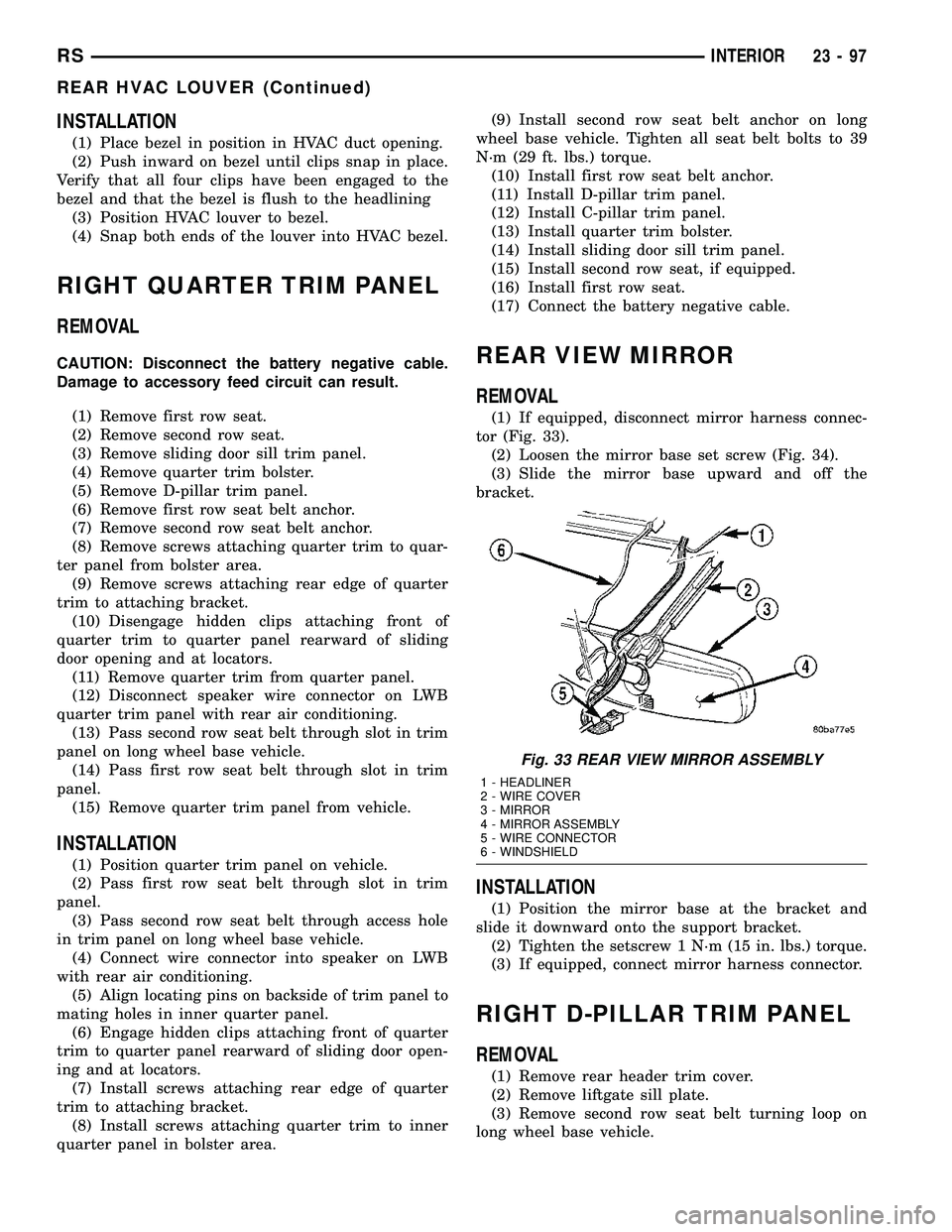
INSTALLATION
(1) Place bezel in position in HVAC duct opening.
(2) Push inward on bezel until clips snap in place.
Verify that all four clips have been engaged to the
bezel and that the bezel is flush to the headlining
(3) Position HVAC louver to bezel.
(4) Snap both ends of the louver into HVAC bezel.
RIGHT QUARTER TRIM PANEL
REMOVAL
CAUTION: Disconnect the battery negative cable.
Damage to accessory feed circuit can result.
(1) Remove first row seat.
(2) Remove second row seat.
(3) Remove sliding door sill trim panel.
(4) Remove quarter trim bolster.
(5) Remove D-pillar trim panel.
(6) Remove first row seat belt anchor.
(7) Remove second row seat belt anchor.
(8) Remove screws attaching quarter trim to quar-
ter panel from bolster area.
(9) Remove screws attaching rear edge of quarter
trim to attaching bracket.
(10) Disengage hidden clips attaching front of
quarter trim to quarter panel rearward of sliding
door opening and at locators.
(11) Remove quarter trim from quarter panel.
(12) Disconnect speaker wire connector on LWB
quarter trim panel with rear air conditioning.
(13) Pass second row seat belt through slot in trim
panel on long wheel base vehicle.
(14) Pass first row seat belt through slot in trim
panel.
(15) Remove quarter trim panel from vehicle.
INSTALLATION
(1) Position quarter trim panel on vehicle.
(2) Pass first row seat belt through slot in trim
panel.
(3) Pass second row seat belt through access hole
in trim panel on long wheel base vehicle.
(4) Connect wire connector into speaker on LWB
with rear air conditioning.
(5) Align locating pins on backside of trim panel to
mating holes in inner quarter panel.
(6) Engage hidden clips attaching front of quarter
trim to quarter panel rearward of sliding door open-
ing and at locators.
(7) Install screws attaching rear edge of quarter
trim to attaching bracket.
(8) Install screws attaching quarter trim to inner
quarter panel in bolster area.(9) Install second row seat belt anchor on long
wheel base vehicle. Tighten all seat belt bolts to 39
N´m (29 ft. lbs.) torque.
(10) Install first row seat belt anchor.
(11) Install D-pillar trim panel.
(12) Install C-pillar trim panel.
(13) Install quarter trim bolster.
(14) Install sliding door sill trim panel.
(15) Install second row seat, if equipped.
(16) Install first row seat.
(17) Connect the battery negative cable.
REAR VIEW MIRROR
REMOVAL
(1) If equipped, disconnect mirror harness connec-
tor (Fig. 33).
(2) Loosen the mirror base set screw (Fig. 34).
(3) Slide the mirror base upward and off the
bracket.
INSTALLATION
(1) Position the mirror base at the bracket and
slide it downward onto the support bracket.
(2) Tighten the setscrew 1 N´m (15 in. lbs.) torque.
(3) If equipped, connect mirror harness connector.
RIGHT D-PILLAR TRIM PANEL
REMOVAL
(1) Remove rear header trim cover.
(2) Remove liftgate sill plate.
(3) Remove second row seat belt turning loop on
long wheel base vehicle.
Fig. 33 REAR VIEW MIRROR ASSEMBLY
1 - HEADLINER
2 - WIRE COVER
3 - MIRROR
4 - MIRROR ASSEMBLY
5 - WIRE CONNECTOR
6 - WINDSHIELD
RSINTERIOR23-97
REAR HVAC LOUVER (Continued)
Page 1877 of 2339
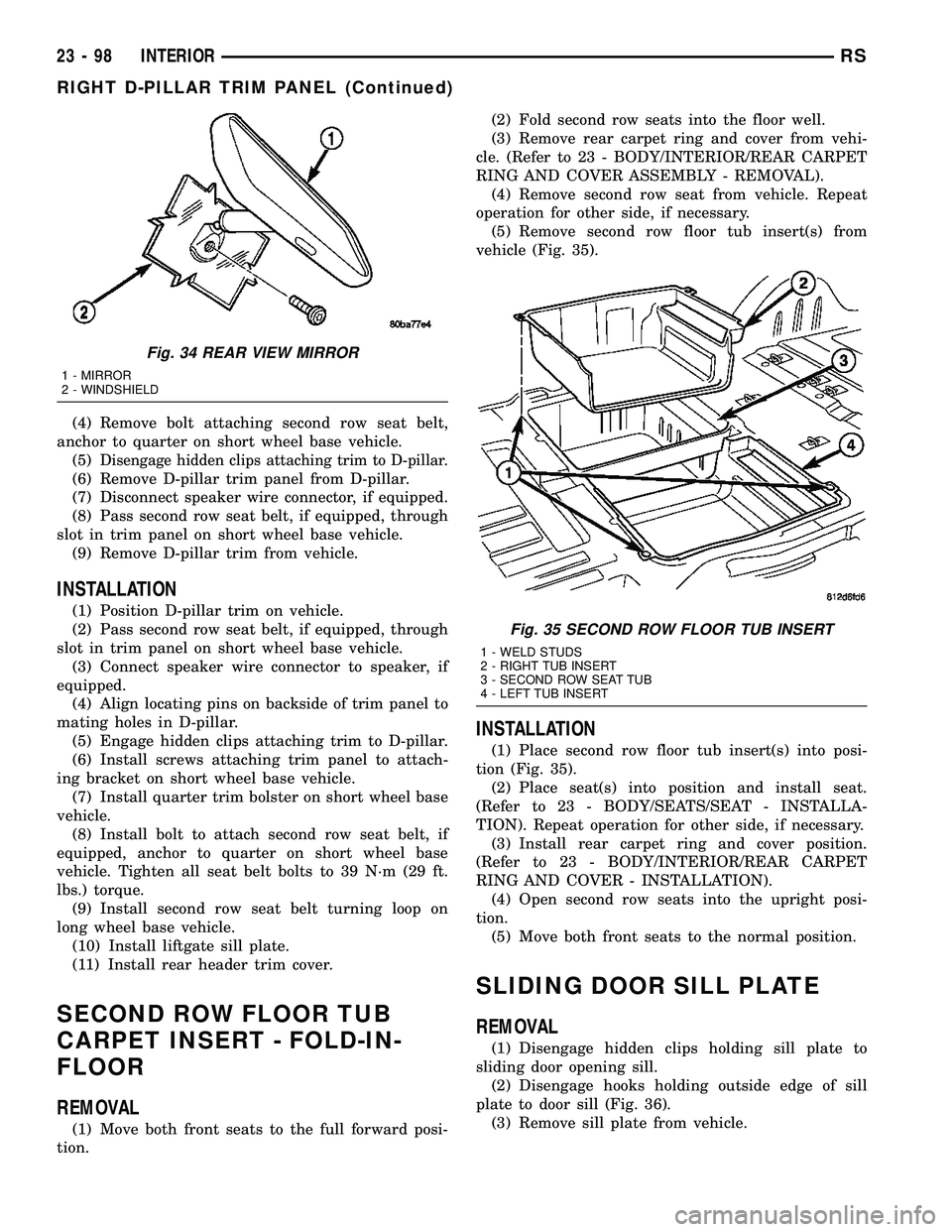
(4) Remove bolt attaching second row seat belt,
anchor to quarter on short wheel base vehicle.
(5)
Disengage hidden clips attaching trim to D-pillar.
(6) Remove D-pillar trim panel from D-pillar.
(7) Disconnect speaker wire connector, if equipped.
(8) Pass second row seat belt, if equipped, through
slot in trim panel on short wheel base vehicle.
(9) Remove D-pillar trim from vehicle.
INSTALLATION
(1) Position D-pillar trim on vehicle.
(2) Pass second row seat belt, if equipped, through
slot in trim panel on short wheel base vehicle.
(3) Connect speaker wire connector to speaker, if
equipped.
(4) Align locating pins on backside of trim panel to
mating holes in D-pillar.
(5) Engage hidden clips attaching trim to D-pillar.
(6) Install screws attaching trim panel to attach-
ing bracket on short wheel base vehicle.
(7) Install quarter trim bolster on short wheel base
vehicle.
(8) Install bolt to attach second row seat belt, if
equipped, anchor to quarter on short wheel base
vehicle. Tighten all seat belt bolts to 39 N´m (29 ft.
lbs.) torque.
(9) Install second row seat belt turning loop on
long wheel base vehicle.
(10) Install liftgate sill plate.
(11) Install rear header trim cover.
SECOND ROW FLOOR TUB
CARPET INSERT - FOLD-IN-
FLOOR
REMOVAL
(1) Move both front seats to the full forward posi-
tion.(2) Fold second row seats into the floor well.
(3) Remove rear carpet ring and cover from vehi-
cle. (Refer to 23 - BODY/INTERIOR/REAR CARPET
RING AND COVER ASSEMBLY - REMOVAL).
(4) Remove second row seat from vehicle. Repeat
operation for other side, if necessary.
(5) Remove second row floor tub insert(s) from
vehicle (Fig. 35).
INSTALLATION
(1) Place second row floor tub insert(s) into posi-
tion (Fig. 35).
(2) Place seat(s) into position and install seat.
(Refer to 23 - BODY/SEATS/SEAT - INSTALLA-
TION). Repeat operation for other side, if necessary.
(3) Install rear carpet ring and cover position.
(Refer to 23 - BODY/INTERIOR/REAR CARPET
RING AND COVER - INSTALLATION).
(4) Open second row seats into the upright posi-
tion.
(5) Move both front seats to the normal position.
SLIDING DOOR SILL PLATE
REMOVAL
(1) Disengage hidden clips holding sill plate to
sliding door opening sill.
(2) Disengage hooks holding outside edge of sill
plate to door sill (Fig. 36).
(3) Remove sill plate from vehicle.
Fig. 34 REAR VIEW MIRROR
1 - MIRROR
2 - WINDSHIELD
Fig. 35 SECOND ROW FLOOR TUB INSERT
1 - WELD STUDS
2 - RIGHT TUB INSERT
3 - SECOND ROW SEAT TUB
4 - LEFT TUB INSERT
23 - 98 INTERIORRS
RIGHT D-PILLAR TRIM PANEL (Continued)
Page 1940 of 2339
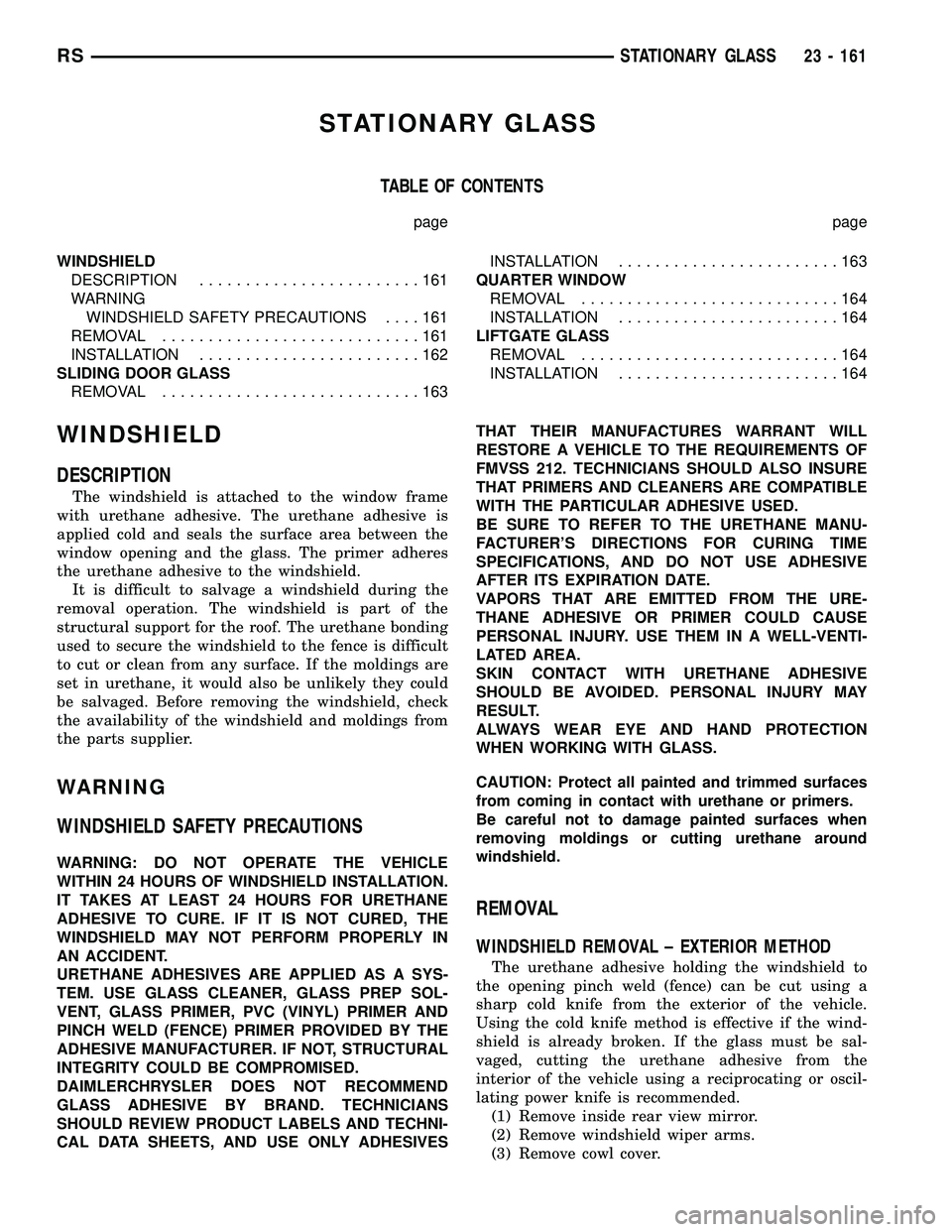
STATIONARY GLASS
TABLE OF CONTENTS
page page
WINDSHIELD
DESCRIPTION........................161
WARNING
WINDSHIELD SAFETY PRECAUTIONS....161
REMOVAL............................161
INSTALLATION........................162
SLIDING DOOR GLASS
REMOVAL............................163INSTALLATION........................163
QUARTER WINDOW
REMOVAL............................164
INSTALLATION........................164
LIFTGATE GLASS
REMOVAL............................164
INSTALLATION........................164
WINDSHIELD
DESCRIPTION
The windshield is attached to the window frame
with urethane adhesive. The urethane adhesive is
applied cold and seals the surface area between the
window opening and the glass. The primer adheres
the urethane adhesive to the windshield.
It is difficult to salvage a windshield during the
removal operation. The windshield is part of the
structural support for the roof. The urethane bonding
used to secure the windshield to the fence is difficult
to cut or clean from any surface. If the moldings are
set in urethane, it would also be unlikely they could
be salvaged. Before removing the windshield, check
the availability of the windshield and moldings from
the parts supplier.
WARNING
WINDSHIELD SAFETY PRECAUTIONS
WARNING: DO NOT OPERATE THE VEHICLE
WITHIN 24 HOURS OF WINDSHIELD INSTALLATION.
IT TAKES AT LEAST 24 HOURS FOR URETHANE
ADHESIVE TO CURE. IF IT IS NOT CURED, THE
WINDSHIELD MAY NOT PERFORM PROPERLY IN
AN ACCIDENT.
URETHANE ADHESIVES ARE APPLIED AS A SYS-
TEM. USE GLASS CLEANER, GLASS PREP SOL-
VENT, GLASS PRIMER, PVC (VINYL) PRIMER AND
PINCH WELD (FENCE) PRIMER PROVIDED BY THE
ADHESIVE MANUFACTURER. IF NOT, STRUCTURAL
INTEGRITY COULD BE COMPROMISED.
DAIMLERCHRYSLER DOES NOT RECOMMEND
GLASS ADHESIVE BY BRAND. TECHNICIANS
SHOULD REVIEW PRODUCT LABELS AND TECHNI-
CAL DATA SHEETS, AND USE ONLY ADHESIVESTHAT THEIR MANUFACTURES WARRANT WILL
RESTORE A VEHICLE TO THE REQUIREMENTS OF
FMVSS 212. TECHNICIANS SHOULD ALSO INSURE
THAT PRIMERS AND CLEANERS ARE COMPATIBLE
WITH THE PARTICULAR ADHESIVE USED.
BE SURE TO REFER TO THE URETHANE MANU-
FACTURER'S DIRECTIONS FOR CURING TIME
SPECIFICATIONS, AND DO NOT USE ADHESIVE
AFTER ITS EXPIRATION DATE.
VAPORS THAT ARE EMITTED FROM THE URE-
THANE ADHESIVE OR PRIMER COULD CAUSE
PERSONAL INJURY. USE THEM IN A WELL-VENTI-
LATED AREA.
SKIN CONTACT WITH URETHANE ADHESIVE
SHOULD BE AVOIDED. PERSONAL INJURY MAY
RESULT.
ALWAYS WEAR EYE AND HAND PROTECTION
WHEN WORKING WITH GLASS.
CAUTION: Protect all painted and trimmed surfaces
from coming in contact with urethane or primers.
Be careful not to damage painted surfaces when
removing moldings or cutting urethane around
windshield.
REMOVAL
WINDSHIELD REMOVAL ± EXTERIOR METHOD
The urethane adhesive holding the windshield to
the opening pinch weld (fence) can be cut using a
sharp cold knife from the exterior of the vehicle.
Using the cold knife method is effective if the wind-
shield is already broken. If the glass must be sal-
vaged, cutting the urethane adhesive from the
interior of the vehicle using a reciprocating or oscil-
lating power knife is recommended.
(1) Remove inside rear view mirror.
(2) Remove windshield wiper arms.
(3) Remove cowl cover.
RSSTATIONARY GLASS23 - 161
Page 1941 of 2339
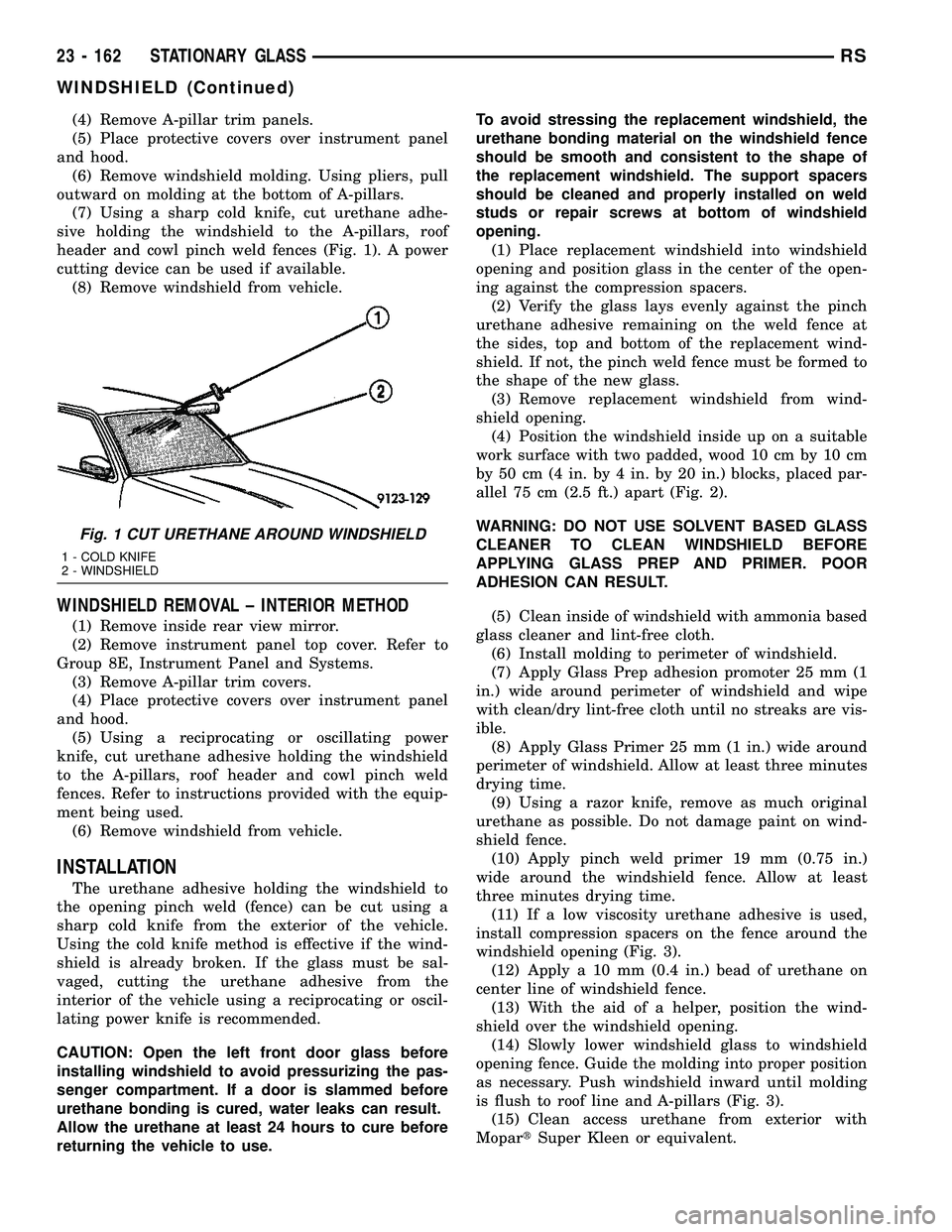
(4) Remove A-pillar trim panels.
(5) Place protective covers over instrument panel
and hood.
(6) Remove windshield molding. Using pliers, pull
outward on molding at the bottom of A-pillars.
(7) Using a sharp cold knife, cut urethane adhe-
sive holding the windshield to the A-pillars, roof
header and cowl pinch weld fences (Fig. 1). A power
cutting device can be used if available.
(8) Remove windshield from vehicle.
WINDSHIELD REMOVAL ± INTERIOR METHOD
(1) Remove inside rear view mirror.
(2) Remove instrument panel top cover. Refer to
Group 8E, Instrument Panel and Systems.
(3) Remove A-pillar trim covers.
(4) Place protective covers over instrument panel
and hood.
(5) Using a reciprocating or oscillating power
knife, cut urethane adhesive holding the windshield
to the A-pillars, roof header and cowl pinch weld
fences. Refer to instructions provided with the equip-
ment being used.
(6) Remove windshield from vehicle.
INSTALLATION
The urethane adhesive holding the windshield to
the opening pinch weld (fence) can be cut using a
sharp cold knife from the exterior of the vehicle.
Using the cold knife method is effective if the wind-
shield is already broken. If the glass must be sal-
vaged, cutting the urethane adhesive from the
interior of the vehicle using a reciprocating or oscil-
lating power knife is recommended.
CAUTION: Open the left front door glass before
installing windshield to avoid pressurizing the pas-
senger compartment. If a door is slammed before
urethane bonding is cured, water leaks can result.
Allow the urethane at least 24 hours to cure before
returning the vehicle to use.To avoid stressing the replacement windshield, the
urethane bonding material on the windshield fence
should be smooth and consistent to the shape of
the replacement windshield. The support spacers
should be cleaned and properly installed on weld
studs or repair screws at bottom of windshield
opening.
(1) Place replacement windshield into windshield
opening and position glass in the center of the open-
ing against the compression spacers.
(2) Verify the glass lays evenly against the pinch
urethane adhesive remaining on the weld fence at
the sides, top and bottom of the replacement wind-
shield. If not, the pinch weld fence must be formed to
the shape of the new glass.
(3) Remove replacement windshield from wind-
shield opening.
(4) Position the windshield inside up on a suitable
work surface with two padded, wood 10 cm by 10 cm
by 50 cm (4 in. by 4 in. by 20 in.) blocks, placed par-
allel 75 cm (2.5 ft.) apart (Fig. 2).
WARNING: DO NOT USE SOLVENT BASED GLASS
CLEANER TO CLEAN WINDSHIELD BEFORE
APPLYING GLASS PREP AND PRIMER. POOR
ADHESION CAN RESULT.
(5) Clean inside of windshield with ammonia based
glass cleaner and lint-free cloth.
(6) Install molding to perimeter of windshield.
(7) Apply Glass Prep adhesion promoter 25 mm (1
in.) wide around perimeter of windshield and wipe
with clean/dry lint-free cloth until no streaks are vis-
ible.
(8) Apply Glass Primer 25 mm (1 in.) wide around
perimeter of windshield. Allow at least three minutes
drying time.
(9) Using a razor knife, remove as much original
urethane as possible. Do not damage paint on wind-
shield fence.
(10) Apply pinch weld primer 19 mm (0.75 in.)
wide around the windshield fence. Allow at least
three minutes drying time.
(11) If a low viscosity urethane adhesive is used,
install compression spacers on the fence around the
windshield opening (Fig. 3).
(12) Apply a 10 mm (0.4 in.) bead of urethane on
center line of windshield fence.
(13) With the aid of a helper, position the wind-
shield over the windshield opening.
(14) Slowly lower windshield glass to windshield
opening fence. Guide the molding into proper position
as necessary. Push windshield inward until molding
is flush to roof line and A-pillars (Fig. 3).
(15) Clean access urethane from exterior with
MopartSuper Kleen or equivalent.
Fig. 1 CUT URETHANE AROUND WINDSHIELD
1 - COLD KNIFE
2 - WINDSHIELD
23 - 162 STATIONARY GLASSRS
WINDSHIELD (Continued)
Page 1942 of 2339
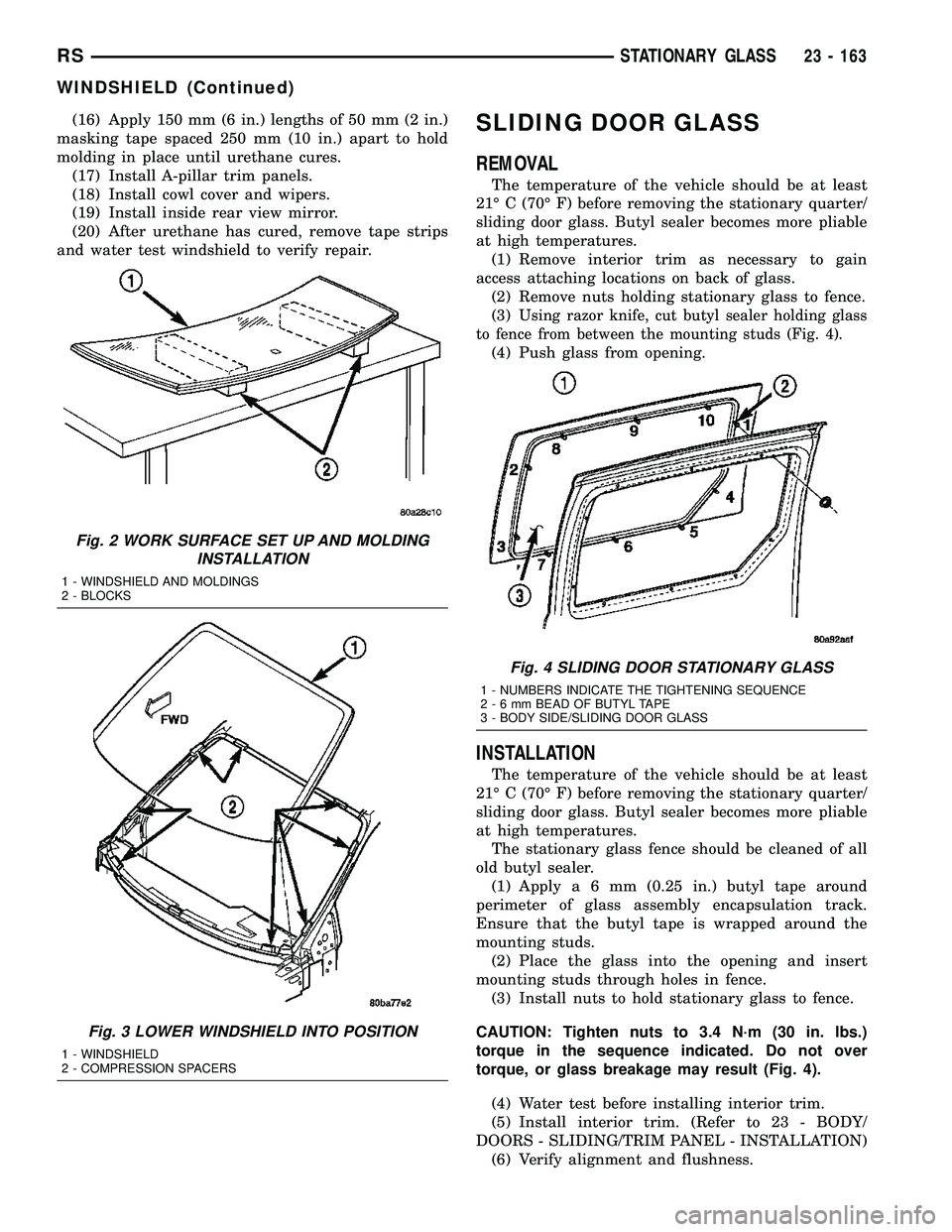
(16) Apply 150 mm (6 in.) lengths of 50 mm (2 in.)
masking tape spaced 250 mm (10 in.) apart to hold
molding in place until urethane cures.
(17) Install A-pillar trim panels.
(18) Install cowl cover and wipers.
(19) Install inside rear view mirror.
(20) After urethane has cured, remove tape strips
and water test windshield to verify repair.SLIDING DOOR GLASS
REMOVAL
The temperature of the vehicle should be at least
21É C (70É F) before removing the stationary quarter/
sliding door glass. Butyl sealer becomes more pliable
at high temperatures.
(1) Remove interior trim as necessary to gain
access attaching locations on back of glass.
(2) Remove nuts holding stationary glass to fence.
(3)
Using razor knife, cut butyl sealer holding glass
to fence from between the mounting studs (Fig. 4).
(4) Push glass from opening.
INSTALLATION
The temperature of the vehicle should be at least
21É C (70É F) before removing the stationary quarter/
sliding door glass. Butyl sealer becomes more pliable
at high temperatures.
The stationary glass fence should be cleaned of all
old butyl sealer.
(1) Applya6mm(0.25 in.) butyl tape around
perimeter of glass assembly encapsulation track.
Ensure that the butyl tape is wrapped around the
mounting studs.
(2) Place the glass into the opening and insert
mounting studs through holes in fence.
(3) Install nuts to hold stationary glass to fence.
CAUTION: Tighten nuts to 3.4 N´m (30 in. lbs.)
torque in the sequence indicated. Do not over
torque, or glass breakage may result (Fig. 4).
(4) Water test before installing interior trim.
(5) Install interior trim. (Refer to 23 - BODY/
DOORS - SLIDING/TRIM PANEL - INSTALLATION)
(6) Verify alignment and flushness.
Fig. 2 WORK SURFACE SET UP AND MOLDING
INSTALLATION
1 - WINDSHIELD AND MOLDINGS
2 - BLOCKS
Fig. 3 LOWER WINDSHIELD INTO POSITION
1 - WINDSHIELD
2 - COMPRESSION SPACERS
Fig. 4 SLIDING DOOR STATIONARY GLASS
1 - NUMBERS INDICATE THE TIGHTENING SEQUENCE
2-6mmBEAD OF BUTYL TAPE
3 - BODY SIDE/SLIDING DOOR GLASS
RSSTATIONARY GLASS23 - 163
WINDSHIELD (Continued)
Page 1946 of 2339

(6) Install fully the entire A-pillar glass run sec-
tion by indexing the molded corner detail into the
roll frame. Slide the glass run up the A-pillar until
the rubber molded joint just touches the roll frame.
(7) Verify that the tertiary seal is on the correct
side of the roll frame prior to seating the glass run
fully onto the frame. Verify the glass runs is fully
seated for the header, and A-pillar and B-pillar
(8) Install screw attaching glass run weatherstrip
to inner door panel.
(9) Install inner belt weatherstrip.
(10) Install watershed.
(11) Push weatherstrip groove onto lip along top of
door frame.
(12) Engage clip into slot in door frame.
(13) Push weatherstrip into channel at rear of door
frame, working from the top to bottom.
(14) Install door frame closeout moldings.
(15) Install door speaker, if equipped.
(16) Install door trim panel.FRONT DOOR OUTER BELT
MOLDING
REMOVAL
(1) Remove the side view mirror. (Refer to 23 -
BODY/EXTERIOR/SIDE VIEW MIRROR -
REMOVAL)
(2) Remove door trim panel.
(3) Roll door glass down.
(4) Using a hook tool, disengage interlocking lip at
the base of the inward edge of the belt molding (Fig.
1).
(5) Remove belt molding from door.
INSTALLATION
(1) Place belt molding in position on door (Fig. 1).
NOTE: Make sure end of applique is against outer
belt.
(2) Engage interlocking lip at the base of the
inward edge of the belt molding on door panel.
(3) Install door trim panel.
Fig. 1 FRONT DOOR WEATHERSTRIP
1 - DOOR GLASS RUN WEATHERSTRIP
2 - FRONT INNER DOOR
3 - DOOR BELT OUTER WEATHERSTRIP4 - DOOR MOUNTED WEATHERSTRIP
5 - DOOR OUTER BELT WEATHERSTRIP
RSWEATHERSTRIP/SEALS23 - 167
FRONT DOOR GLASS RUN WEATHERSTRIP (Continued)
Page 2156 of 2339
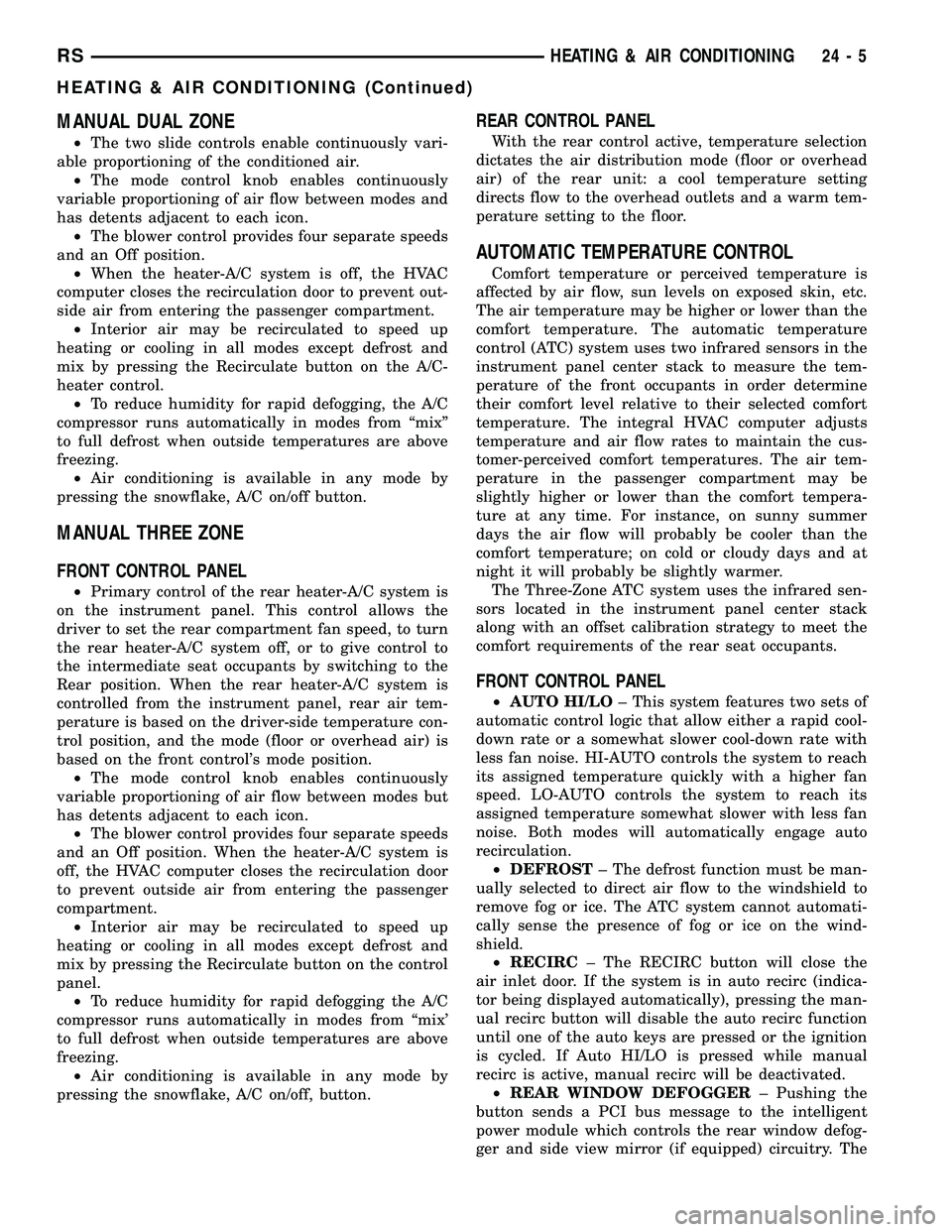
MANUAL DUAL ZONE
²The two slide controls enable continuously vari-
able proportioning of the conditioned air.
²The mode control knob enables continuously
variable proportioning of air flow between modes and
has detents adjacent to each icon.
²The blower control provides four separate speeds
and an Off position.
²When the heater-A/C system is off, the HVAC
computer closes the recirculation door to prevent out-
side air from entering the passenger compartment.
²Interior air may be recirculated to speed up
heating or cooling in all modes except defrost and
mix by pressing the Recirculate button on the A/C-
heater control.
²To reduce humidity for rapid defogging, the A/C
compressor runs automatically in modes from ªmixº
to full defrost when outside temperatures are above
freezing.
²Air conditioning is available in any mode by
pressing the snowflake, A/C on/off button.
MANUAL THREE ZONE
FRONT CONTROL PANEL
²Primary control of the rear heater-A/C system is
on the instrument panel. This control allows the
driver to set the rear compartment fan speed, to turn
the rear heater-A/C system off, or to give control to
the intermediate seat occupants by switching to the
Rear position. When the rear heater-A/C system is
controlled from the instrument panel, rear air tem-
perature is based on the driver-side temperature con-
trol position, and the mode (floor or overhead air) is
based on the front control's mode position.
²The mode control knob enables continuously
variable proportioning of air flow between modes but
has detents adjacent to each icon.
²The blower control provides four separate speeds
and an Off position. When the heater-A/C system is
off, the HVAC computer closes the recirculation door
to prevent outside air from entering the passenger
compartment.
²Interior air may be recirculated to speed up
heating or cooling in all modes except defrost and
mix by pressing the Recirculate button on the control
panel.
²To reduce humidity for rapid defogging the A/C
compressor runs automatically in modes from ªmix'
to full defrost when outside temperatures are above
freezing.
²Air conditioning is available in any mode by
pressing the snowflake, A/C on/off, button.
REAR CONTROL PANEL
With the rear control active, temperature selection
dictates the air distribution mode (floor or overhead
air) of the rear unit: a cool temperature setting
directs flow to the overhead outlets and a warm tem-
perature setting to the floor.
AUTOMATIC TEMPERATURE CONTROL
Comfort temperature or perceived temperature is
affected by air flow, sun levels on exposed skin, etc.
The air temperature may be higher or lower than the
comfort temperature. The automatic temperature
control (ATC) system uses two infrared sensors in the
instrument panel center stack to measure the tem-
perature of the front occupants in order determine
their comfort level relative to their selected comfort
temperature. The integral HVAC computer adjusts
temperature and air flow rates to maintain the cus-
tomer-perceived comfort temperatures. The air tem-
perature in the passenger compartment may be
slightly higher or lower than the comfort tempera-
ture at any time. For instance, on sunny summer
days the air flow will probably be cooler than the
comfort temperature; on cold or cloudy days and at
night it will probably be slightly warmer.
The Three-Zone ATC system uses the infrared sen-
sors located in the instrument panel center stack
along with an offset calibration strategy to meet the
comfort requirements of the rear seat occupants.
FRONT CONTROL PANEL
²AUTO HI/LO± This system features two sets of
automatic control logic that allow either a rapid cool-
down rate or a somewhat slower cool-down rate with
less fan noise. HI-AUTO controls the system to reach
its assigned temperature quickly with a higher fan
speed. LO-AUTO controls the system to reach its
assigned temperature somewhat slower with less fan
noise. Both modes will automatically engage auto
recirculation.
²DEFROST± The defrost function must be man-
ually selected to direct air flow to the windshield to
remove fog or ice. The ATC system cannot automati-
cally sense the presence of fog or ice on the wind-
shield.
²RECIRC± The RECIRC button will close the
air inlet door. If the system is in auto recirc (indica-
tor being displayed automatically), pressing the man-
ual recirc button will disable the auto recirc function
until one of the auto keys are pressed or the ignition
is cycled. If Auto HI/LO is pressed while manual
recirc is active, manual recirc will be deactivated.
²REAR WINDOW DEFOGGER± Pushing the
button sends a PCI bus message to the intelligent
power module which controls the rear window defog-
ger and side view mirror (if equipped) circuitry. The
RSHEATING & AIR CONDITIONING24-5
HEATING & AIR CONDITIONING (Continued)
Page 2316 of 2339
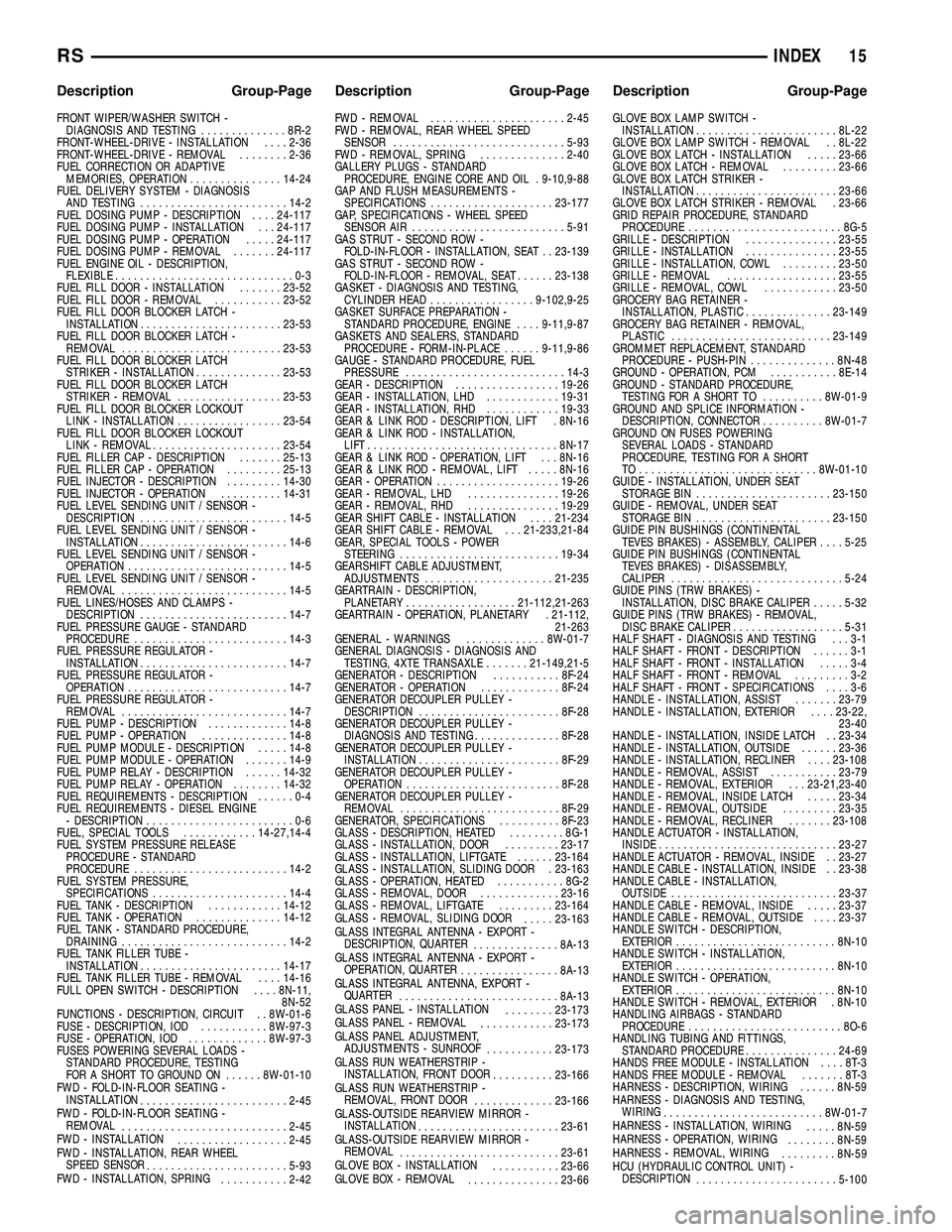
FRONT WIPER/WASHER SWITCH -DIAGNOSIS AND TESTING ..............8R-2
FRONT-WHEEL-DRIVE - INSTALLATION ....2-36
FRONT-WHEEL-DRIVE - REMOVAL ........2-36
FUEL CORRECTION OR ADAPTIVE MEMORIES, OPERATION ...............14-24
FUEL DELIVERY SYSTEM - DIAGNOSIS AND TESTING ........................ 14-2
FUEL DOSING PUMP - DESCRIPTION ....24-117
FUEL DOSING PUMP - INSTALLATION . . . 24-117
FUEL DOSING PUMP - OPERATION .....24-117
FUEL DOSING PUMP - REMOVAL .......24-117
FUEL ENGINE OIL - DESCRIPTION, FLEXIBLE .............................0-3
FUEL FILL DOOR - INSTALLATION .......23-52
FUEL FILL DOOR - REMOVAL ...........23-52
FUEL FILL DOOR BLOCKER LATCH - INSTALLATION ....................... 23-53
FUEL FILL DOOR BLOCKER LATCH - REMOVAL .......................... 23-53
FUEL FILL DOOR BLOCKER LATCH STRIKER - INSTALLATION ..............23-53
FUEL FILL DOOR BLOCKER LATCH STRIKER - REMOVAL .................23-53
FUEL FILL DOOR BLOCKER LOCKOUT LINK - INSTALLATION .................23-54
FUEL FILL DOOR BLOCKER LOCKOUT LINK - REMOVAL ..................... 23-54
FUEL FILLER CAP - DESCRIPTION .......25-13
FUEL FILLER CAP - OPERATION .........25-13
FUEL INJECTOR - DESCRIPTION .........14-30
FUEL INJECTOR - OPERATION ..........14-31
FUEL LEVEL SENDING UNIT / SENSOR - DESCRIPTION ........................ 14-5
FUEL LEVEL SENDING UNIT / SENSOR - INSTALLATION ........................ 14-6
FUEL LEVEL SENDING UNIT / SENSOR - OPERATION .......................... 14-5
FUEL LEVEL SENDING UNIT / SENSOR - REMOVAL ........................... 14-5
FUEL LINES/HOSES AND CLAMPS - DESCRIPTION ........................ 14-7
FUEL PRESSURE GAUGE - STANDARD PROCEDURE ......................... 14-3
FUEL PRESSURE REGULATOR - INSTALLATION ........................ 14-7
FUEL PRESSURE REGULATOR - OPERATION .......................... 14-7
FUEL PRESSURE REGULATOR - REMOVAL ........................... 14-7
FUEL PUMP - DESCRIPTION .............14-8
FUEL PUMP - OPERATION ..............14-8
FUEL PUMP MODULE - DESCRIPTION .....14-8
FUEL PUMP MODULE - OPERATION .......14-9
FUEL PUMP RELAY - DESCRIPTION ......14-32
FUEL PUMP RELAY - OPERATION ........14-32
FUEL REQUIREMENTS - DESCRIPTION ......0-4
FUEL REQUIREMENTS - DIESEL ENGINE - DESCRIPTION ........................0-6
FUEL, SPECIAL TOOLS ............14-27,14-4
FUEL SYSTEM PRESSURE RELEASE PROCEDURE - STANDARD
PROCEDURE ......................... 14-2
FUEL SYSTEM PRESSURE, SPECIFICATIONS ...................... 14-4
FUEL TANK - DESCRIPTION ............14-12
FUEL TANK - OPERATION ..............14-12
FUEL TANK - STANDARD PROCEDURE, DRAINING ........................... 14-2
FUEL TANK FILLER TUBE - INSTALLATION ....................... 14-17
FUEL TANK FILLER TUBE - REMOVAL ....14-16
FULL OPEN SWITCH - DESCRIPTION ....8N-11,
8N-52
FUNCTIONS - DESCRIPTION, CIRCUIT . . 8W-01-6
FUSE - DESCRIPTION, IOD ...........8W-97-3
FUSE - OPERATION, IOD .............8W-97-3
FUSES POWERING SEVERAL LOADS - STANDARD PROCEDURE, TESTING
FOR A SHORT TO GROUND ON ......8W-01-10
FWD - FOLD-IN-FLOOR SEATING - INSTALLATION ........................ 2-45
FWD - FOLD-IN-FLOOR SEATING - REMOVAL ........................... 2-45
FWD - INSTALLATION ..................2-45
FWD - INSTALLATION, REAR WHEEL SPEED SENSOR ....................... 5-93
FWD - INSTALLATION, SPRING ...........2-42FWD - REMOVAL
...................... 2-45
FWD - REMOVAL, REAR WHEEL SPEED SENSOR ............................ 5-93
FWD - REMOVAL, SPRING ..............2-40
GALLERY PLUGS - STANDARD PROCEDURE, ENGINE CORE AND OIL . 9-10,9-88
GAP AND FLUSH MEASUREMENTS - SPECIFICATIONS .................... 23-177
GAP, SPECIFICATIONS - WHEEL SPEED SENSOR AIR ......................... 5-91
GAS STRUT - SECOND ROW - FOLD-IN-FLOOR - INSTALLATION, SEAT . . 23-139
GAS STRUT - SECOND ROW - FOLD-IN-FLOOR - REMOVAL, SEAT ......23-138
GASKET - DIAGNOSIS AND TESTING, CYLINDER HEAD ................. 9-102,9-25
GASKET SURFACE PREPARATION - STANDARD PROCEDURE, ENGINE ....9-11,9-87
GASKETS AND SEALERS, STANDARD PROCEDURE - FORM-IN-PLACE ......9-11,9-86
GAUGE - STANDARD PROCEDURE, FUEL PRESSURE .......................... 14-3
GEAR - DESCRIPTION .................19-26
GEAR - INSTALLATION, LHD ............19-31
GEAR - INSTALLATION, RHD ............19-33
GEAR & LINK ROD - DESCRIPTION, LIFT . 8N-16
GEAR & LINK ROD - INSTALLATION, LIFT ............................... 8N-17
GEAR & LINK ROD - OPERATION, LIFT . . . 8N-16
GEAR & LINK ROD - REMOVAL, LIFT .....8N-16
GEAR - OPERATION .................... 19-26
GEAR - REMOVAL, LHD ...............19-26
GEAR - REMOVAL, RHD ...............19-29
GEAR SHIFT CABLE - INSTALLATION ....21-234
GEAR SHIFT CABLE - REMOVAL . . . 21-233,21-84
GEAR, SPECIAL TOOLS - POWER STEERING .......................... 19-34
GEARSHIFT CABLE ADJUSTMENT, ADJUSTMENTS ..................... 21-235
GEARTRAIN - DESCRIPTION, PLANETARY .................. 21-112,21-263
GEARTRAIN - OPERATION, PLANETARY . 21-112, 21-263
GENERAL - WARNINGS .............8W-01-7
GENERAL DIAGNOSIS - DIAGNOSIS AND TESTING, 4XTE TRANSAXLE .......21-149,21-5
GENERATOR - DESCRIPTION ...........8F-24
GENERATOR - OPERATION .............8F-24
GENERATOR DECOUPLER PULLEY - DESCRIPTION ....................... 8F-28
GENERATOR DECOUPLER PULLEY - DIAGNOSIS AND TESTING ..............8F-28
GENERATOR DECOUPLER PULLEY - INSTALLATION ....................... 8F-29
GENERATOR DECOUPLER PULLEY - OPERATION ......................... 8F-28
GENERATOR DECOUPLER PULLEY - REMOVAL .......................... 8F-29
GENERATOR, SPECIFICATIONS ..........8F-23
GLASS - DESCRIPTION, HEATED .........8G-1
GLASS - INSTALLATION, DOOR .........23-17
GLASS - INSTALLATION, LIFTGATE ......23-164
GLASS - INSTALLATION, SLIDING DOOR . 23-163
GLASS - OPERATION, HEATED ...........8G-2
GLASS - REMOVAL, DOOR .............23-16
GLASS - REMOVAL, LIFTGATE .........23-164
GLASS - REMOVAL, SLIDING DOOR .....23-163
GLASS INTEGRAL ANTENNA - EXPORT - DESCRIPTION, QUARTER ..............8A-13
GLASS INTEGRAL ANTENNA - EXPORT - OPERATION, QUARTER ................8A-13
GLASS INTEGRAL ANTENNA, EXPORT - QUARTER .......................... 8A-13
GLASS PANEL - INSTALLATION ........23-173
GLASS PANEL - REMOVAL ............23-173
GLASS PANEL ADJUSTMENT, ADJUSTMENTS - SUNROOF ...........23-173
GLASS RUN WEATHERSTRIP - INSTALLATION, FRONT DOOR ..........23-166
GLASS RUN WEATHERSTRIP - REMOVAL, FRONT DOOR .............23-166
GLASS-OUTSIDE REARVIEW MIRROR - INSTALLATION ....................... 23-61
GLASS-OUTSIDE REARVIEW MIRROR - REMOVAL .......................... 23-61
GLOVE BOX - INSTALLATION ...........23-66
GLOVE BOX - REMOVAL ...............23-66GLOVE BOX LAMP SWITCH -
INSTALLATION ....................... 8L-22
GLOVE BOX LAMP SWITCH - REMOVAL . . 8L-22
GLOVE BOX LATCH - INSTALLATION .....23-66
GLOVE BOX LATCH - REMOVAL .........23-66
GLOVE BOX LATCH STRIKER - INSTALLATION ....................... 23-66
GLOVE BOX LATCH STRIKER - REMOVAL . 23-66
GRID REPAIR PROCEDURE, STANDARD PROCEDURE ......................... 8G-5
GRILLE - DESCRIPTION ...............23-55
GRILLE - INSTALLATION ...............23-55
GRILLE - INSTALLATION, COWL .........23-50
GRILLE - REMOVAL ..................23-55
GRILLE - REMOVAL, COWL ............23-50
GROCERY BAG RETAINER - INSTALLATION, PLASTIC ..............23-149
GROCERY BAG RETAINER - REMOVAL, PLASTIC .......................... 23-149
GROMMET REPLACEMENT, STANDARD PROCEDURE - PUSH-PIN ..............8N-48
GROUND - OPERATION, PCM ...........8E-14
GROUND - STANDARD PROCEDURE, TESTING FOR A SHORT TO ..........8W-01-9
GROUND AND SPLICE INFORMATION - DESCRIPTION, CONNECTOR ..........8W-01-7
GROUND ON FUSES POWERING SEVERAL LOADS - STANDARD
PROCEDURE, TESTING FOR A SHORT
TO.............................8W -01-10
GUIDE - INSTALLATION, UNDER SEAT STORAGE BIN ...................... 23-150
GUIDE - REMOVAL, UNDER SEAT STORAGE BIN ...................... 23-150
GUIDE PIN BUSHINGS (CONTINENTAL TEVES BRAKES) - ASSEMBLY, CALIPER ....5-25
GUIDE PIN BUSHINGS (CONTINENTAL TEVES BRAKES) - DISASSEMBLY,
CALIPER ............................ 5-24
GUIDE PINS (TRW BRAKES) - INSTALLATION, DISC BRAKE CALIPER .....5-32
GUIDE PINS (TRW BRAKES) - REMOVAL, DISC BRAKE CALIPER .................. 5-31
HALF SHAFT - DIAGNOSIS AND TESTING . . . 3-1
HALF SHAFT - FRONT - DESCRIPTION ......3-1
HALF SHAFT - FRONT - INSTALLATION .....3-4
HALF SHAFT - FRONT - REMOVAL .........3-2
HALF SHAFT - FRONT - SPECIFICATIONS ....3-6
HANDLE - INSTALLATION, ASSIST .......23-79
HANDLE - INSTALLATION, EXTERIOR ....23-22,
23-40
HANDLE - INSTALLATION, INSIDE LATCH . . 23-34
HANDLE - INSTALLATION, OUTSIDE ......23-36
HANDLE - INSTALLATION, RECLINER ....23-108
HANDLE - REMOVAL, ASSIST ...........23-79
HANDLE - REMOVAL, EXTERIOR . . . 23-21,23-40
HANDLE - REMOVAL, INSIDE LATCH .....23-34
HANDLE - REMOVAL, OUTSIDE .........23-35
HANDLE - REMOVAL, RECLINER .......23-108
HANDLE ACTUATOR - INSTALLATION, INSIDE ............................. 23-27
HANDLE ACTUATOR - REMOVAL, INSIDE . . 23-27
HANDLE CABLE - INSTALLATION, INSIDE . . 23-38
HANDLE CABLE - INSTALLATION, OUTSIDE ........................... 23-37
HANDLE CABLE - REMOVAL, INSIDE .....23-37
HANDLE CABLE - REMOVAL, OUTSIDE ....23-37
HANDLE SWITCH - DESCRIPTION, EXTERIOR .......................... 8N-10
HANDLE SWITCH - INSTALLATION, EXTERIOR .......................... 8N-10
HANDLE SWITCH - OPERATION, EXTERIOR .......................... 8N-10
HANDLE SWITCH - REMOVAL, EXTERIOR . 8N-10
HANDLING AIRBAGS - STANDARD PROCEDURE ......................... 8O-6
HANDLING TUBING AND FITTINGS, STANDARD PROCEDURE ...............24-69
HANDS FREE MODULE - INSTALLATION ....8T-3
HANDS FREE MODULE - REMOVAL .......8T-3
HARNESS - DESCRIPTION, WIRING ......8N-59
HARNESS - DIAGNOSIS AND TESTING, WIRING ..........................8W -01-7
HARNESS - INSTALLATION, WIRING .....8N-59
HARNESS - OPERATION, WIRING ........8N-59
HARNESS - REMOVAL, WIRING .........8N-59
HCU (HYDRAULIC CONTROL UNIT) - DESCRIPTION ....................... 5-100
RS INDEX15
Description Group-Page Description Group-Page Description Group-Page